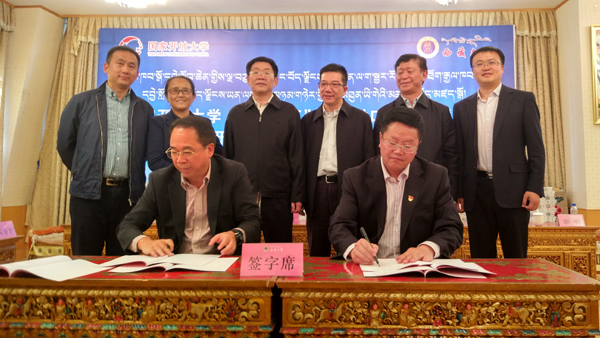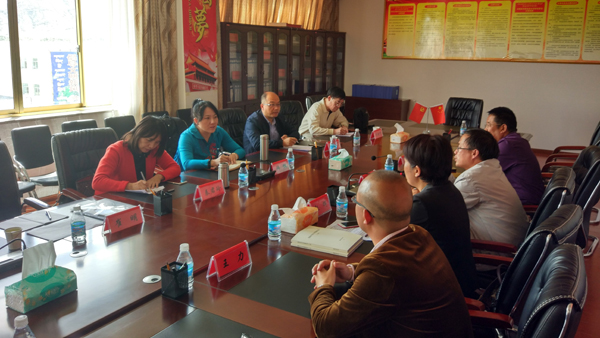 On 16th September , 2017, Tibet University hosted a signing ceremony on an Agreement to Provide Assistance for Tibet University in the Co-construction of an OUC (the Open University of China) Branch in Tibet during the 13th Five-Year Plan.
On 16th September , 2017, Tibet University hosted a signing ceremony on an Agreement to Provide Assistance for Tibet University in the Co-construction of an OUC (the Open University of China) Branch in Tibet during the 13th Five-Year Plan.

Zhu Xiaojie, deputy director of the Department of Minority Education at the Ministry of Education(MOE), Du Jiangong, the vice secretary of the Education Work Committee and the director of Tibet Autonomous Region’s Education Department, CiRen Duobujie, a MOE Department of Minority Education inspector, as well as party group member and deputy director (at the department level) of Tibet Autonomous Region’s Education Department, Yang Zhijian, the OUC president, Qi Yanwei, OUC’s vice president, Ji Jianzhou, a member of Tibet Autonomous Region’s Education Work Committee, as well as the vice Party secretary and president of Tibet University, and Yang Zhen, a Party member and vice president of Tibet University, all attended the ceremony, which was also attended by relevant personnel from the OUC, Tibet University, and Tibet Autonomous Region’s Education Department.
Yang Zhijian and Ji Jianzhou signed the Agreement to Provide Assistance for Tibet University in the Co-construction of an OUC Tibet Branch during the 13th Five-Year Plan. Yang Zhen presided over the signing ceremony.
Yang Zhijian said that the OUC would continue to work together with the Tibet University during the 13th Five-Year period. The OUC will treat the work of providing educational assistance for Tibet as a political task. It will enhance school operating conditions at both the Tibet branch and its study centre, educational information levels, as well as the ability and quality of teachers and administrators. The OUC plans to integrate and share high-quality educational resources, build major courses with Tibetan characteristics, and improve personnel training quality, all of which will transform the Tibetan Institute into an innovative OUC Tibet Branch. The OUC will leverage its systemic characteristics and advantages to develop targeted "group" assistance, define objectives and tasks, complete the phased annual tasks, explore a distance education talent training model suitable for Tibet, expand educational opportunities, promote educational equity, and develop the Tibet Branch into an important lifelong learning platform for Tibetan people.
Ji Jianzhou noted that, during the 12th Five-Year period, with the OUC’s assistance, information-based teaching facilities at the School of Tibet were improved considerably, network learning resources grew richer, and much reform and development was achieved. These positive contributions facilitated the construction of a learning society in Tibet. Today, the two parties signed an agreement to help the Tibet Branch continue to develop in an improved manner.
After Tibet Autonomous Region’s Education Department approved the Tibet School, it was established in 2002. The school was co-founded by the OUC and Tibet University to provide distance education in Tibet. During the 12th Five-Year period, the OUC vigorously assisted with its construction, and comprehensively promoted its comprehensive, multi-level assistance work through human, material, and financial resources. This further improved the school’s operating conditions, both in terms of quality and magnitude. It also cultivated a cohort of talents for the economic and social development of Tibet, and became an important part of the education movement in the autonomous region.
Over the past 15 years, the OUC has provided the School of Tibet with a fund of nearly 12 million yuan, in addition to a large number of information technology devices and learning resources. The Tibet School established five study centres, one each in Lhasa, Lhoka, Shigatse, Nyingchi, and Qamdo. It also launched seven undergraduate majors, including Chinese language and literature, accounting, and administrative management, and five junior college majors, including nursing, modern clerking, and so on. A cumulative total enrollment of 12,208 students has resulted in 7,076 graduates, while 5,132 remain currently enrolled. After the Tibet branch’s founding, it will be the OUC’s 45th branch school.

At the same time, in order to strengthen quality control, and improve the quality of education and teaching, on 14th September, the OUC’s teaching special supervision group supervised at the School of Tibet. OUC vice president Qi Yanwei, and several department directors, participated in the supervisory work, and discussed the Agreement to Provide Assistance for Tibet University with the Co-construction of an OUC Branch in Tibet during the 13th Five-Year Plan. Yang Zhen, the vice president of Tibet University and the dean of the School of Tibet, Zhang Jinshu, the OUC School of Tibet’s Party secretary, Ci Ren, the School of Tibet’s executive vice dean, vice dean Qin Junling, and the School’s entire staff took part in the discussion. Ci Ren then compiled a report on the teaching special supervision work. On 15th September, the OUC’s teaching special supervision group headed to Shigatse study centre. On 18th September , the group returned suggestions and opinions to the Tibet Branch. Tibet University and the School of Tibet had previously held a special mobilisation meeting, established a teaching leadership group with Yang Zhan as its head, formulated the 2017 Plan of Open Education and Teaching Supervision for the School of Tibet, and performed a self-examination of its special teaching supervision.
By Xu Mingjun, OUC